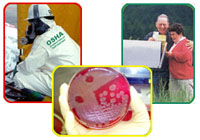|
 Personal protective equipment (PPE) shields
or isolates workers from health and safety hazards in the workplace.
In a site where anthrax spores may be present, PPE protects workers
from exposure to respiratory and skin hazards and prevents the
spread of contaminants to uncontaminated areas. Personal protective equipment (PPE) shields
or isolates workers from health and safety hazards in the workplace.
In a site where anthrax spores may be present, PPE protects workers
from exposure to respiratory and skin hazards and prevents the
spread of contaminants to uncontaminated areas.
| Skin
Protection |
 Wearing
protective clothing protects the skin and can prevent the
transfer of contamination off-site. The appropriate level of
skin protection, which should be outlined in the HASP,
is determined based on the site conditions. The appropriate
level of skin protection used at an anthrax-impacted site
should include, at a minimum, the following: Wearing
protective clothing protects the skin and can prevent the
transfer of contamination off-site. The appropriate level of
skin protection, which should be outlined in the HASP,
is determined based on the site conditions. The appropriate
level of skin protection used at an anthrax-impacted site
should include, at a minimum, the following:
- Tyvek or equivalent coveralls
- Unpowdered disposable gloves made of lightweight nitrile
or vinyl
Appropriate PPE selection will take
into account the following:
-
 Does it protect the skin from contact with anthrax
spores? Does it protect the skin from contact with anthrax
spores?
- Does it protect the worker form contact with chemicals
used in the response?
- Does it protect the worker from other site hazards
identified in the HASP?
- Can it can be taken off safely and left at the site to prevent
the transfer of contamination off-site.
The following links include more detailed
information on Skin Protection:
|
| Respiratory
Protection |
 Since airborne spores
generally pose the greatest threat to personnel, respiratory
protection is a necessary component of the PPE program. The
OSHA respiratory protection standard (29
CFR 1910.134) requires you to
establish and comply with an effective respiratory program.
Program requirements include: Since airborne spores
generally pose the greatest threat to personnel, respiratory
protection is a necessary component of the PPE program. The
OSHA respiratory protection standard (29
CFR 1910.134) requires you to
establish and comply with an effective respiratory program.
Program requirements include:
- Program administration;
- Worksite-specific procedures, respirator selection,
employee training, fit testing;
- Medical evaluation; and
- Respirator use, cleaning, maintenance, and repair.
To date, experience has shown the following
to provide adequate protection for most response, sampling, and
decontamination activities involving spores:
- Powered air-purifying respirators (PAPRs) with P100 filters,
or
- Full-face negative pressure air purifying respirators (APRs)
with N95 filters.
Some emergency response operations may
require that first responders wear the following with their normal
Hazardous Material response ensembles:
- Self-Contained Breathing Apparatus (SCBA).
The following links include more detailed
information on Respiratory Protection:
|
| PPE
Training |
 It
is essential that personnel be trained on the proper use of PPE to
ensure they receive greatest protection possible. Employers should
certify in writing that the training has been provided and that
employees understand what they need to know about PPE. The
certification should show the name of each employee trained and the
dates and types of training provided. It
is essential that personnel be trained on the proper use of PPE to
ensure they receive greatest protection possible. Employers should
certify in writing that the training has been provided and that
employees understand what they need to know about PPE. The
certification should show the name of each employee trained and the
dates and types of training provided.
Workers should be trained
to know:
- When PPE is necessary
- What type of PPE to use
- Where the PPE is located
- How the PPE should be worn
- What the PPE limitations are
- How long the PPE is likely to last
- How to properly maintain and dispose of the PPE
In addition, appropriate personnel
decontamination and contamination containment procedures are needed
for workers using PPE to prevent exposure to anthrax. In general,
these procedures are similar to those for asbestos abatement and
include:
- Isolating contaminated areas
- Negative-pressure ventilation
- A three- to five-stage decontamination line with a shower for
equipment and personnel
- Appropriate waste disposal
For additional detailed information about
Respiratory Protection see the following:
|
|
|
 Personal protective equipment (PPE) shields
or isolates workers from health and safety hazards in the workplace.
In a site where anthrax spores may be present, PPE protects workers
from exposure to respiratory and skin hazards and prevents the
spread of contaminants to uncontaminated areas.
Personal protective equipment (PPE) shields
or isolates workers from health and safety hazards in the workplace.
In a site where anthrax spores may be present, PPE protects workers
from exposure to respiratory and skin hazards and prevents the
spread of contaminants to uncontaminated areas.

 Newsletter
Newsletter RSS Feeds
RSS Feeds Print This Page
Print This Page
 Text Size
Text Size


 Does it protect the skin from contact with anthrax
spores?
Does it protect the skin from contact with anthrax
spores?
